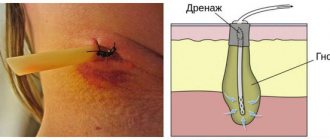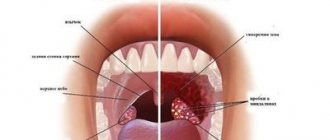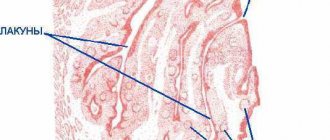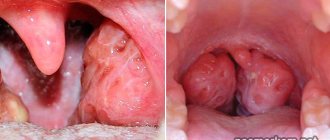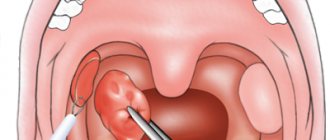The inflammatory process in the tonsils (tonsillitis) may be accompanied by tonsillitis plugs. A plug in the palatine tonsil is an accumulation of purulent masses in its lacunae. Such formations not only bring discomfort to the patient, but can also provoke serious complications. In our article we will tell you how to get rid of tonsillitis stones and how to treat purulent tonsillitis in Moscow.
The tonsils of a healthy body are capable of self-cleaning. With frequent or prolonged sore throats, this function of the tonsils weakens; white or yellowish lumps, consisting of dead leukocytes, bacteria, calcium and other substances, begin to accumulate in the lacunae - these are almond stones or tonsillitis. More often, this problem occurs with chronic tonsillitis, when the patient begins to self-medicate, starting to take certain medications uncontrollably, or does not follow doctor’s orders and stops taking antibiotics ahead of schedule.
Causes and symptoms of the disease
Inflammation in the tonsils, leading to the appearance of plugs, can be caused by the following reasons:
- existing chronic diseases of the ENT organs (for example, chronic rhinitis);
- inflammatory processes in the oral cavity (carious teeth) and nasal cavity (sinusitis);
- deformed nasal septum;
- increase in the size of adenoid vegetations;
- weakened immune system, stress;
- hypothermia of the body;
- tonsil injuries
The main causative agents of tonsillitis are staphylococci, streptococci, and adenoviruses.
The formation of plugs is indicated by symptoms such as: bad breath, visible accumulations of pus on the tonsils, enlargement of the palatine arches, enlarged lymph nodes, pain when swallowing. The patient complains of constant weakness. The temperature may rise, and in some cases the pain radiates to the ear.
When the first symptoms appear, it is necessary to promptly remove tonsillitis caseous masses so as not to start the disease and prevent possible complications: rheumatism, heart disease, kidney disease, etc.
Chronic tonsillitis in children
The diagnosis of chronic tonsillitis is detected in 15% of children. In childhood, the most common cause of chronic inflammation of the tonsils is untreated tonsillitis (acute tonsillitis). Also, chronic tonsillitis can develop against the background of adenoids, dental diseases, a deviated nasal septum, allergies, hypothermia and weak immunity. The hereditary factor plays a major role. If the mother or father of the child has a history of this diagnosis, then the child is likely to develop the disease as well.
Treatment of tonsillitis plugs
Palatine tonsils in Moscow should be treated under the supervision of an otolaryngologist. Conservative treatment of tonsil plugs in Moscow includes the use of antibiotics (amoxcillin, sumamed, erythromycin), rinsing with antiseptics (Miramistin, Rotokan, Chlorhexidine), and lubricating the tonsils with Lugol's solution. To relieve pain, you can dissolve special lozenges (“Faringosept”, “Strepsils”). To relieve swelling, antihistamines are prescribed. If you have a fever, you need to take antipyretics.
Removing plugs using a vacuum using the Tonsillor device is highly effective. First, using the Tonsillor nozzle, a vacuum is created to remove purulent masses - the purulent contents of the lacunae are sucked out into a special cup. After treatment (sanitation), the palatine tonsil is exposed to ultrasound.
The main rule when removing traffic jams is that you cannot get rid of the problem at home.
Some patients try to clean their tonsils themselves by scooping out the pus with their fingers or a toothpick. Firstly, this measure is ineffective, since only plaque on the surface is removed, and not accumulations of pus inside the lacunae; secondly, this can injure the tonsils.
Treatment methods for chronic tonsillitis
Chronic inflammation of the palatine tonsils in the early stages is treated conservatively, of course, under the supervision of an otolaryngologist. Only an ENT doctor, after an examination and confirmation of the diagnosis, can prescribe an effective treatment regimen and carefully remove plugs, which will significantly increase the remission stage and make you forget about the symptoms of the disease for a long time.
Drug therapy includes:
- a course of taking antibacterial drugs (“Azithromycin”, “Augmentin”, “Summamed”, etc.);
- treatment of the tonsils with antiseptic drugs (Lugol);
- taking antihistamines to relieve swelling of the mucous membranes (Claritin, Zodak, etc.);
- gargling with antiseptics (“Miramistin”, “Chlorhexidine”, “Furacilin”);
- irrigating the pharynx with anti-inflammatory sprays (Ingalipt, Hexoral).
Among the traditional medicine recipes in the fight against inflamed tonsils, gargling with herbal decoctions (sage, chamomile, St. John's wort) and inhalation, where decoctions of the same medicinal herbs are used as a solution, have proven themselves to be effective.
Friends! Timely and correct treatment will ensure you a speedy recovery!
Physiotherapeutic procedures that are carried out in the ENT clinic help to consolidate the positive effect of drug therapy and speed up the healing process: laser therapy, ultraviolet irradiation, vibroacoustic effects, etc.
Make an appointment right now!
Call us by phone or use the feedback form
Sign up
Folk remedies can be used in parallel with prescribed therapy (but not instead!) and only in consultation with an ENT doctor.
Only an ENT doctor should remove one or another drug from the treatment regimen or add a new one. Self-medication is unacceptable: many cases have been recorded where improper treatment of inflamed tonsils led to complications in other human organs and systems: complications in the heart, kidneys and joints.
I would like to dwell in more detail on how to properly remove traffic jams.
Surgery
In case of ineffective treatment with conservative methods or frequently recurring tonsillitis (if inflammation occurs more than 2-3 times a year), the ENT doctor may recommend partial or complete removal of the tonsils. The operation is called tonsillectomy. It has a number of contraindications, such as: blood diseases, diabetes, kidney disease, tuberculosis and a number of others. There are several options for performing a tonsillectomy:
- using scissors, a loop and a scalpel;
- using a laser;
- ultrasonic scalpel;
- cold radio knife (coblation).
The operation itself lasts about half an hour. After it, a sore throat, nausea, and bleeding are possible. Depending on the method of surgical intervention, the patient is discharged 2-10 days after the intervention. The attending physician will definitely give a number of recommendations that will need to be followed at home for a speedy recovery.
Why are tonsil plugs dangerous?
Such a process in the tonsils cannot be ignored; in some cases, the discharge in the lacunae is populated by hemolytic streptococcus , the antigenic structure of which is very similar to the antigenic structure of a number of tissues in our body, namely: cardiac muscle, kidney parenchyma, synovial bursa (articular tissue). Antibodies that the body diligently produces, unable to cope with the infection in the tonsils, can attack its own tissues, leading to rheumatic pathology: rheumatism, rheumatoid arthritis, etc. And these are only the most serious complications; most often, having such a lesion in the oropharynx, we feel it affecting our quality of life. Any hypothermia leads to inflammation of the tonsils of the back wall of the pharynx: sore throat, nasal congestion appear, otitis media, sinusitis, that is, an infection that has found refuge in the tonsils, appears when the opportunity arises and the body’s resistance decreases: hypothermia under air conditioning, during active recreation in the cold season, etc., it begins to actively reproduce and seed the mucous membranes with its pathogenic flora.
Complications of tonsillitis plugs
- Peritonsillar abscess is an acute purulent inflammation of the peritonsillar tissue, when bacteria from the tonsils spread to nearby tissues. The main symptoms of the disease are acute sore throat on one side, bad breath, spasms of the chewing muscles, and high body temperature.
- Cellulitis of the neck is a purulent-inflammatory disease when infection from the tonsils penetrates into the tissue of the neck. The main signs are a rapidly growing lump in the neck, high body temperature, difficulty moving the head, swallowing and breathing. The condition is life-threatening for the patient.
- Heart diseases: arrhythmia, myocarditis, endocarditis.
- Kidney diseases: pyelonephritis, glomerulonephritis.
- Joint diseases: rheumatism, scleroderma, systemic lupus erythematosus.
- Complications of pregnancy: miscarriage, premature birth.
- Hair loss. The body begins to consider hair follicles as foreign structures, and active hair loss begins.
- Skin diseases: dermatosis, psoriasis, neurodermatitis, acne.
- Hormonal imbalances, which lead to excess weight, diabetes, and decreased male reproductive function.
- Problems with the nervous system: headaches, tinnitus, lack of sleep, fatigue.
- Excessive sweating.
Congestion in the throat - a protective reaction to contact with infectious agents
The palatine tonsils consist of many lacunae - small passages that communicate with each other, as well as crypts (folds), due to which the area of contact with infectious agents increases and a protective reaction occurs faster.
Bacteria, viruses and other infectious agents enter the body with food. As you know, tonsils are organs of the immune system that help our body in forming a local immune response.
Normally, when microbes and food debris accumulate in the crypts, dense formations containing desquamated epithelium are formed. These tonsilloliths are small and evacuate unnoticed by humans. They are not dangerous in themselves and do not require attention in the absence of a clinic. Physiologically, when swallowing, self-cleaning of lacunae occurs.
During an inflammatory reaction, a disruption of this process is observed and complaints appear.
Clinical manifestations: - discomfort in the throat, tickling - sensation of a foreign body in the throat, urge to cough - frequent ARVI - bad breath - tickling - increased body temperature to 37.1-37.5 C in the evenings - weakness, fatigue.
The accumulation of a large number of caseous masses and pus leads to the formation of a chronic focus of infection and leads to the development of chronic tonsillitis. Large plugs are easy to see and patients often squeeze them out on their own using various blunt objects. For this purpose, various improvised means are often used: spoons, fingers, tongue, toothpicks... Such self-medication can lead to inflammation. During strong mechanical compression, microtraumas occur, through which microbes penetrate the mucosa.
WHAT CAN YOU DO YOURSELF? We recommend rinsing with HIGHLY carbonated mineral water. A liquid with gas dissolved in it and during the formation of bubbles helps to evacuate the contents. You can add a teaspoon of Chlorophyllipt to the solution.
Treatment: 1. Washing - refers to a conservative method. It is carried out using a special “suction cup” or an atraumatic cannula. 2. Lakunotomy (expansion of lacunae using laser, radio waves, and creation of optimal conditions for self-cleaning). 3. tonsillectomy - complete removal of the tonsils, performed only in case of decompensated form => recurrent tonsillitis, history of paratonsillar abscesses, tonsillogenic intoxication).
Prevention measures
To reduce the likelihood of tonsillitis plugs, you need to follow a number of preventive measures:
- Maintain your dental hygiene. Do not forget to brush your teeth in the morning and evening, rinse your mouth after eating, this will prevent the growth of pathogenic microflora in the oral cavity.
- Treat carious teeth and other oral diseases in a timely manner. Visit your dentist once every six months for preventative care. Do not delay treatment for nasopharyngeal diseases. When the first signs of such diseases appear, contact an ENT doctor.
- Strengthen your body's immunity: spend more time outdoors, eat a balanced diet, engage in physical activity, and give up bad habits.
- Dress according to the weather: do not get too cold or overheat.
FAQ
How can you get tonsillitis?
Chronic tonsillitis cannot be contracted.
Chronic inflammation of the palatine tonsils is most often a consequence of untreated tonsillitis (acute tonsillitis), as well as the effect on the human body of a number of provoking factors: poor ecology, constant interaction with harmful substances at work, hypothermia, poor diet, stress, the presence of chronic diseases of the nasopharynx, bad habits , weakened immunity. Do inhalations help with tonsillitis?
Inhalations can be used as part of the drug treatment of chronic tonsillitis.
But if you rely only on them, there will be no result. An integrated approach is important in treating the disease. The correct treatment tactics include drug therapy, washing the palatine tonsils from tonsillitis plugs, as well as physiotherapeutic procedures. Only this approach will bring a positive therapeutic effect. Do I need to follow a diet if I have a congestion in my throat?
Of course, you need to adjust your diet.
Do not get carried away with fried, spicy, sour, and over-salted foods. Do not consume citrus fruits or alcohol. Food should not be too hot or, conversely, cold. In a word, avoid everything that can irritate the mucous membrane of the pharynx and tonsils. Are tonsil plugs dangerous during pregnancy?
Yes, chronic tonsillitis during pregnancy carries a risk of miscarriage or premature birth. If a girl has chronic tonsillitis, before planning a pregnancy, it is recommended to undergo a course of comprehensive treatment for chronic tonsillitis in order to reduce the bacterial load on the body, and then repeat the treatment in the second trimester.
We care about your health
Palatine tonsils or, as they are also called, tonsils , are located in the nasopharynx. They represent a concentration of lymphoid tissue and perform two important functions. The hematopoietic one is most important at an early age, and the protective one is responsible for immunity - general and local. The tonsils are the first to take the blow that viruses and bacteria inflict on the body. Frequent sore throats and viral infections, as well as decreased immunity, contribute to the development of chronic tonsillitis - inflammation of the tonsils. This disease - tonsillitis, according to statistics, is diagnosed in every 10th adult and in 15% of children. At the initial stage, the pathology often responds to conservative therapy, including physical therapy. If there is no progress in the treatment of chronic tonsillitis, the doctor recommends removing the tonsils using surgery - tonsillectomy. The operation is performed in several ways, but the most effective and safest is the removal of tonsils (tonsils) using a laser.
Tonsillitis - what the disease looks like
What does a healthy throat look like?
What does tonsillitis look like - inflammation of the tonsils (glands)
Preparing for tonsillectomy surgery
Laser tonsillectomy is a highly precise, bloodless operation that uses a laser system. A source of directed laser radiation affects the inflamed tonsils, their tissue is excised. Radical laser tonsillectomy involves removing the entire tonsils to remove a chronic source of infection.
Benefits of tonsillectomy:
- There is no bleeding, compared to classical surgery, there is no need for electrocoagulation of blood vessels, as well as subsequent antibacterial therapy.
- A tonsillectomy does not require general anesthesia.
- Possibility of performing the intervention on an outpatient basis.
- Long-term recovery is not required, and the patient’s ability to work is not affected.
The procedure does not require special preparation. The patient is prescribed a set of standard tests - urine and blood tests, if necessary - ECG, conclusions of other specialists. The operation itself lasts no more than 30 minutes. Depending on the degree of damage to the tonsils, surgery can be performed using different types of laser:
- holmium;
- fiber optic;
- carbon;
- infrared.
Carrying out a tonsillectomy under anesthesia involves local anesthesia - an anesthetic drug is applied to the mucous membrane. The patient feels only numbness or slight tingling during the operation. The doctor then grasps the tonsil using forceps and uses a laser beam to excise the tissue. Removal occurs in 4 approaches - each on average 15 seconds. There is no bleeding, since under the influence of the laser tissue the vessels instantly coagulate.
Indications for laser tonsil removal
Removal of tonsils is carried out according to strict indications, although several decades ago this operation was prescribed for preventive purposes. But later experts proved that preserving the tonsils is very important for the immune system. Indications for intervention include:
- Frequent relapses of chronic tonsillitis (more than 4 times a year).
- Lack of effectiveness of antibacterial treatment.
- Complications on the kidneys, heart, joint damage (rheumatism).
- Significant proliferation of tonsil tissue, which causes breathing and swallowing problems.
If there is significant damage to both tonsils and taking into account the client’s wishes, the doctor may prescribe a tonsillectomy under general anesthesia. In the event that there are no contraindications to this.
Inflammation of the tonsils (glands) - photo
Chronic tonsillitis - enlarged tonsils interfere with swallowing
Tonsillitis - inflammation of the tonsils (glands), a chronic form of the disease
How is recovery going after surgery to remove tonsils?
The use of anesthesia during tonsillectomy allows the patient not to experience discomfort during the operation. But 2-3 hours after it, unpleasant sensations may appear in the throat - they are relieved with the help of painkillers. On days 2–3, the postoperative field is covered with a white-yellow film, which disappears after about a week.
The total duration of the rehabilitation period is two to three weeks. It ends when complete epithelization of the wound surface occurs. All this time, the patient must follow the doctor’s recommendations:
- On the day of the operation, you are allowed to drink a little water, but you cannot eat.
- Over the next few days, the diet should consist of pureed food at room temperature - purees, liquid porridge.
- For another 14–16 days, you should avoid sour, spicy and hot foods - they can cause irritation of the mucous membrane that has not completely healed.
- Heavy physical activity, hot baths, visiting a bathhouse or sauna are prohibited.
During the rehabilitation period, difficulty in nasal breathing may occur, caused by swelling of the nasopharynx. The condition will be alleviated by vasoconstrictor drops - they should only be prescribed by a doctor. We treat tonsillitis (remove tonsils/tonsils) with the Medkvadrat ENT clinic.
Tonsillectomy surgery in Moscow is performed in many medical institutions. But contacting the Medkvadrat network of family health clinics guarantees you the following benefits:
- You will be assisted by highly qualified doctors and extensive experience.
- Modern high-tech equipment facilitates accurate diagnosis and increases the efficiency and safety of treatment.
- An individual treatment regimen is selected for each patient, taking into account the severity of the pathology, the characteristics of the body, and the general state of health. Our specialists will select the most effective and safe method.
- You come for a consultation with a specialist who will accompany you from the beginning of treatment to its completion. This approach allows you to achieve maximum results, since the doctor is aware of each stage of therapy.
When prescribing a tonsillectomy, the price of the operation depends on the type of laser that will be used during the operation, the complexity of the manipulations, and the qualifications of the surgeon. The doctor will tell you the exact amount after clarifying the diagnosis and determining the scale of the surgical intervention. He will help you make your choice and carefully explain the importance of timely treatment.
Treatment at the ENT Clinic of Doctor Zaitsev
You can remove tonsillitis plugs in Moscow effectively and painlessly in our clinic. The high professionalism and extensive experience of the clinic’s specialists allows us to confidently declare: the treatment of chronic tonsillitis is our specialty. We use the most modern equipment from leading global manufacturers. Here you can get rid of almond plugs with a vacuum using the improved “Tonsillor” nozzle. This is our invention, our “know-how”, which has no analogues in Moscow. This attachment is much more effective than the usual Tonsillor attachment, less traumatic and painless. The procedure for cleansing the tonsils using this attachment becomes much more effective. It can even be used when treating children.
Prices in our clinic have not changed for 3 years, and are among the best in the capital. Call, make an appointment and come! We will help you cope with the disease!
Always yours, Doctor Zaitsev.
About the author:
ENT doctor of the highest category, candidate of medical sciences. Sci.
Removing tonsillitis plugs: how to remove them correctly?
Removal of caseous masses from the lacunae of the palatine tonsils is the most important part of the treatment of chronic tonsillitis, which should be carried out by an experienced ENT doctor in the clinic. Many patients mistakenly believe that they can remove the purulent contents of the tonsils on their own. A wide variety of items are used: from spoons and matches to toothpicks. Some people manage to remove traffic jams with cotton swabs or their tongue. But we strongly do not recommend resorting to such measures. Attempts to pick out purulent plugs can result in damage to the delicate tissues of the tonsils and infection of the wounds, since rarely do any patients observe proper sterility standards during the procedure.
Modern ENT clinics offer two ways to get rid of plugs: rinsing the palatine tonsils with a syringe and rinsing the palatine tonsils using the Tonzillor apparatus. Removing plugs with a syringe is done less and less often: this method is traumatic and does not allow you to fully wash the tonsils.
The second method is considered the most effective. The nozzle of the Tonsillor device is brought to the tonsil and, like a vacuum cleaner, draws out the purulent contents of the tonsils into the nozzle cup. True, due to the fact that the nozzle cup is opaque, the ENT doctor does not always see whether the tonsils are completely washed - so he has to carry out several additional procedures to remove the caseous masses for sure.
"Doctor Zaitsev's ENT Clinic" offers a third method: removing plugs using a modified attachment of the "Tonsillor" device.
There are no analogues of such a nozzle in any of the Moscow clinics, since it is a unique development of the founder of the “ENT Clinic of Doctor Zaitsev” - Vladimir Mikhailovich Zaitsev and his colleagues.
The improved nozzle is much more convenient than its predecessor. Its rounded edges do not injure the tissue of the tonsils, which sometimes happens with a conventional nozzle, and the transparent cup of the nozzle, into which the contents of the lacunae are washed out, immediately helps the doctor understand when the procedure can be completed without conducting unnecessary sessions. Thereby saving the patient time and money. The attachment can be used even when treating small patients - its small size is ideal for children.
